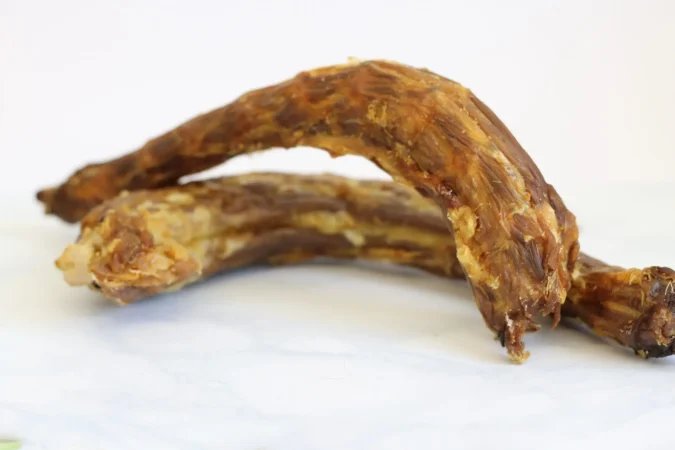Dehydrated duck necks are becoming a popular treat for dogs due to their natural and tasty appeal. Many pet owners are curious about whether they can safely feed this treat to their dogs, especially when considering the benefits and possible risks. Dogs love the chewy texture of duck necks, and it’s packed with protein, which can be good for their overall health.
However, as with any new treat, it’s essential to understand both the pros and cons before introducing dehydrated duck necks to your dog’s diet. While some dogs may love the taste and find it satisfying, it’s important to keep portions in check and monitor for any adverse reactions. There are also some considerations like choking hazards, especially for smaller dogs, so always supervise your dog while enjoying these treats.
CAN DOGS EAT DEHYDRATED DUCK NECKS?
Yes, dogs can eat dehydrated duck necks, and they can be a great natural treat for your pet. Packed with protein and essential nutrients, dehydrated duck necks offer dogs a satisfying chew that promotes dental health and provides a good source of glucosamine, which supports joint health. However, it’s important to feed them in moderation and ensure that they’re prepared properly to avoid choking hazards, especially for small dogs.
Always monitor your dog while they enjoy the treat, and consult your vet if you have concerns about allergies or digestive issues. Dehydrated duck necks can be a healthy and tasty addition to your dog’s diet when served safely.

WHAT ARE DEHYDRATED DUCK NECKS?
Dehydrated duck necks are a natural, chewable dog treat made from duck necks that have been dried through a dehydration process. The dehydration removes moisture from the bones and meat, which helps preserve them for longer storage while maintaining most of the essential nutrients.
In factories, duck necks are typically processed through a dehydration method to preserve them and make them suitable for sale as dog treats. The process begins with selecting fresh duck necks, which are thoroughly cleaned to remove any dirt or contaminants. Once cleaned, the necks are placed in large dehydrators where heat and air circulate around them to remove moisture. This helps prevent spoilage and preserves the nutritional content, keeping the meat and bones intact. The dehydration process can take several hours to days, depending on the method and desired texture. After dehydration, the duck necks are carefully inspected for quality and then packaged for sale in various forms—sometimes in a mixed bag with other treats. These packaged duck necks are then shipped to stores, where they are available for purchase by pet owners. The drying process ensures that the treats remain shelf-stable, which makes them convenient and long-lasting for consumers.
NUTRITIONAL ANALYSIS
Dehydrated duck necks are packed with several beneficial nutrients that can support your dog’s overall health. Here’s a list of the key nutrients they contain: (analysis is based on 100 gram)
Calories: 350 kcal
- Protein: 50 grams
- Fat: 20 grams
- Carbohydrates: 0 grams
- Fiber: 0 grams
- Calcium: 100 mg
- Phosphorus: 200 mg
- Omega-3 Fatty Acids: 1.5 grams
- Glucosamine: 150 mg
- Chondroitin: 100 mg
- Vitamins (B1, B2, B6, etc.): 20 mg
ARE DEHYDRATED DUCK NECKS SAFE FOR DOGS?
Dehydrated duck necks can be safe for dogs when given in moderation, but like any treat, they come with both benefits and risks. Here is an overlook on pros and cons, based on which you can conclude with a result:
PROS
Dehydrated duck necks offer a variety of benefits that can support your dog’s overall health and well-being. Here are 8 advantages of feeding your dog dehydrated duck necks:
- Dental hygiene: Chewing on tough items like duck necks provides abrasion against your dog’s teeth, helping to clean off food material and prevent plaque formation.
- High protein: Duck necks are a great protein source, promoting the growth of muscles and supporting enzyme production and DNA synthesis.
- Healthy joints: The connective tissue and cartilage in duck necks contain glucosamine and chondroitin, which help reduce joint pain and improve weight-bearing on afflicted limbs in dogs with osteoarthritis.
- Calcium: Duck necks provide a necessary nutrient for strong gums and enamel, as well as supporting muscle contractions and helping with overall bone health.
- High fat content: A vital source of energy, high fat content makes duck necks an excellent treat for lean dogs or active dogs to fuel their metabolism.
- Mental stimulation: The act of chewing on duck necks provides your dog with mental stimulation, helping to keep them engaged and reducing boredom.
- Natural alternative: As a raw treat, duck necks serve as a more natural alternative to many store-bought treats, often free from artificial additives and preservatives.
- Improves chewing habits: Regular chewing on tough treats like duck necks can encourage better chewing habits and help clean teeth, making it easier to maintain your dog’s dental health over time.
CONS
Some pet owners may worry about whether dehydration causes heat to make the bones even more fragile. In my experience, even though the moisture is removed, the bones can still be a bit sharp, which requires caution when giving them to your dog.
Additionally, not every dog will chew them in the same way, and chewing on hard neck bones can sometimes be too much for small dogs. I’ve had a situation where my dog would leave pieces of neck bones behind after chewing, which can be frustrating. If your dog is not interested in chewing on raw bones or struggles with the treat, it might be disappointing. Here’s a breakdown of the potential cons of feeding dehydrated duck necks:
- Risk of Splintering – The bone may break into small, sharp pieces, leading to the possibility of injury to your dog’s mouth or digestive system.
- Brittle Texture – Due to the dehydration, the bones could become brittle, making them easier to break and harder to chew for some dogs.
- Choking Hazard – Small dogs might struggle with the size or hardness of the neck bones, creating a potential choking risk.
- Not for All Dogs – Some dogs may not enjoy chewing on the bones, as seen with my own experience when my dog didn’t seem interested in treats like trachea.
- Store-Bought vs. Homemade – If you rely on store-bought options, the bones might come in a mixed bag, and you could end up with pieces your dog doesn’t like or isn’t suitable for them.
- Disappointment in Quality – Sometimes, old or poorly stored duck necks might not be as appealing to your dog, leading to disappointment.
- Too Big for Small Dogs – The size of the bones might not be suitable for dogs with small mouths, causing discomfort or difficulty when chewing.
If you’re unsure, always remember to check the treat quality and be prepared to adjust the type or size of the treats based on your dog’s preferences. Regularly brushing your dog’s teeth can still help in keeping their mouth clean, even if they don’t love the treats.
HOW MUCH DEHYDRATED DUCK NECKS SHOULD I GIVE TO DOGS?
Here is a suggested frequency and portion chart for feeding dehydrated duck necks to dogs based on their weight:
| Dog's Weight | Recommended Frequency | Portion Size (Duck Necks) |
|---|---|---|
| 5 - 10 lbs. | 1-2 times per week | 1/2 duck neck |
| 10 - 25 lbs. | 1-2 times per week | 1 whole duck neck |
| 25 - 50 lbs. | 2-3 times per week | 1-2 whole duck necks |
| 50 - 75 lbs. | 2-3 times per week | 2-3 whole duck necks |
| 75 - 100 lbs. | 2-3 times per week | 3 whole duck necks |
WHICH DEHYDRATED DUCK NECKS ARE BEST FOR DOGS?
When choosing the best dehydrated duck necks for dogs, here are a few key factors to consider:
- Quality of Ingredients: Look for brands that offer 100% natural duck necks without any added chemicals, preservatives, or artificial flavorings. This ensures your dog is getting a healthy and safe treat.
- Sourcing: Choose brands that source their duck necks from trusted suppliers. Ideally, the ducks should be raised in a humane environment without unnecessary antibiotics or hormones.
- Size and Freshness: Make sure the duck necks are appropriately sized for your dog’s breed and weight. Some brands offer cut-to-size options for smaller dogs, while larger dogs may benefit from bigger, whole duck necks.
- Packaging: Look for well-sealed packaging that keeps the duck necks fresh and free from contamination. The packaging should also mention if the product is dehydrated, ensuring a safe, long-lasting treat.
- Brand Reputation: Popular brands known for high-quality treats for pets, such as Zuke’s or Vital Essentials, often offer premium dehydrated treats that are well-reviewed by dog owners. Always check reviews to ensure the quality and safety of the product.
HOW TO PREPARE DEHYDRATED DUCK NECKS AT HOME?
Making homemade dehydrated duck necks for your dog can be a rewarding experience and a healthier option than store-bought alternatives. By preparing them at home, you can ensure that you’re using only natural, high-quality ingredients, without any hidden preservatives or additives. Homemade treats also give you control over the size and texture, making them safer and more tailored to your dog’s needs. Here’s a simple step-by-step guide to preparing dehydrated duck necks for your dog:
- Purchase High-Quality Duck Necks
Start with fresh, high-quality duck necks from a reputable source. Make sure they are free from added preservatives or artificial chemicals. - Clean the Duck Necks
Rinse the duck necks thoroughly with cold water to remove any residual dirt or bone fragments. Pat them dry with a towel. - Cut into Manageable Pieces (Optional)
If your dog is small or has trouble chewing larger pieces, consider cutting the duck necks into smaller, bite-sized chunks. - Dehydrate the Duck Necks
Use a dehydrator to dry the duck necks, or you can place them in an oven set to a low temperature (around 150-170°F). The drying process can take anywhere from 8-12 hours, depending on your method and the thickness of the necks. - Store Properly
Once the duck necks are fully dehydrated, store them in an airtight container in a cool, dry place to maintain their freshness. They can last for weeks if stored correctly. - Serve as a Treat
Offer the dehydrated duck necks to your dog in moderation. Always supervise your dog while they enjoy the treat to prevent choking hazards, especially with smaller dogs.
CAN DOGS EAT CHICKEN NECKS?
Yes, dogs can eat chicken necks, but there are some important factors to consider. Chicken necks can provide benefits like supporting dental hygiene and joint health, as they are rich in calcium, collagen, and protein. However, there are some risks associated with feeding them to your dog.
Here’s a quick breakdown:
- Benefits: Chewing on chicken necks can help clean teeth, reduce plaque, and support healthy joints due to the collagen and glucosamine found in the cartilage.
- Risks: Raw chicken necks can carry bacteria like Salmonella, and cooked chicken necks can splinter, leading to potential choking hazards or damage to your dog’s digestive system. Always supervise your dog when they’re eating chicken necks and consider feeding raw, fresh ones from a trusted source or dehydrated options from reputable brands.
It’s best to consult with your vet to ensure chicken necks are suitable for your dog, especially if they have any pre-existing health conditions.
FINAL THOUGHTS
Dehydrated duck necks can be a healthy treat for dogs, offering benefits like dental hygiene and joint health. However, they come with some risks, such as choking hazards and the potential for splintering. Always monitor your dog while they chew and feed in moderation. Ensure the necks are from a trusted source and appropriately sized for your pet. Consult with your vet to ensure it’s suitable for your dog’s specific health needs. With proper care, dehydrated duck necks can be a great addition to your dog’s diet.
FREQUENTLY ASKED QUESTIONS





1 thought on “Danger: Is It Safe for Dog to Eat Dehydrated Duck Necks?”